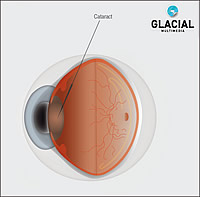What Are Cataracts?

 A cataract is clouding of the eye’s internal lens. The lens sits behind the pupil and focuses light onto the retina in the back of the eye. Once the focused light reaches the retina, the visual information is sent to the brain. Various parts of the brain then help us to process the images we see. When young, the lens is a flexible disc that changes shape in order to focus on objects as near and far away.
A cataract is clouding of the eye’s internal lens. The lens sits behind the pupil and focuses light onto the retina in the back of the eye. Once the focused light reaches the retina, the visual information is sent to the brain. Various parts of the brain then help us to process the images we see. When young, the lens is a flexible disc that changes shape in order to focus on objects as near and far away.
As we reach our mid to late forties, the lens begins to naturally lose its flexibility, and loses the ability to see near and far.
In addition, over years, the lens usually clouds and limits smooth transit of light. This clouding process is called a cataract, and usually occurs in both eyes simultaneously. Most cataracts develop as the eyes age naturally, but they can also result from trauma, genetics, prior surgeries, disease, or a congenital problem.


